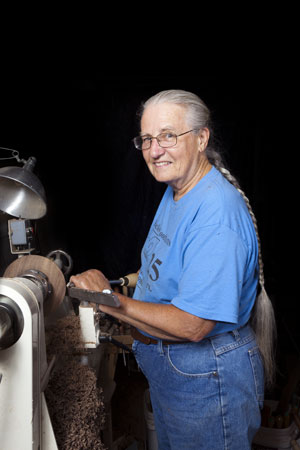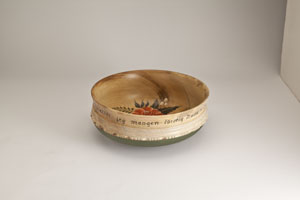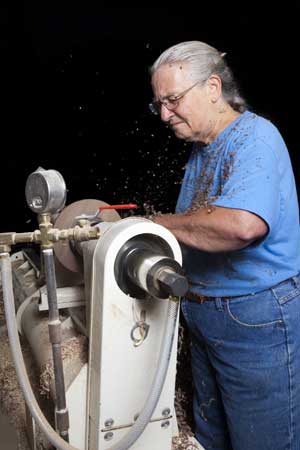
A while back, Rob’s eZine editorial sent out a call for woodturning eZine readers. We promised to select some, send them some wood, feature them in the magazine — and declare a winner. And so we did.
The four selected woodturners (Tim Aley, John Bare, Nancy Rourke and Ed Weber) and the objects they turned from blocks of myrtle are featured in the September/Octoberprint issue of Woodworker’s Journal (on newsstands very, very soon — for those of you who don’t get it in your mailboxes at home).
And the winner is (drumroll, please): Nancy J. Rourke.
Nancy, of Perkasie, Pennsylvania, received a $150 Rockler Woodworking and Hardware gift certificate. (Other contestants received $100 Rockler gift certificates.)
Nancy turned a couple of bowls back in the 1970s with a Sears lathe she picked up for $10 or $15 at an auction, but it was after her retirement that she got serious about turning, taking classes from Bucks County, Pennsylvania, turner Dave Hardy. He taught a six-month, once-a-week class with “all the basics you needed to know,” and by the time she finished the class, Nancy had upgraded her lathe to a Oneway.
She can’t turn anything larger than 12″ on that particular lathe so, by necessity, most of what she makes is small — and includes “a little bit of everything. I haven’t gotten to the point where I specialize in anything,” Nancy said. “I turn useful things, trying to make them with a nice form and shape, and pretty: bowls and plates and boxes and ornaments.”
Nancy is a member of the Bucks Wood Turners chapter of the American Association of Woodturners, which she says “plays a big part in my knowing and loving turning.” She finds inspiration from the show-and-tell aspect of seeing what other members are doing, as well as the demonstrations from nationally known turners.
She has also found an interest in rosemaling, a Norwegian form of decorative painting traditionally done on wooden objects. Nancy has added rosemaling to her plates and bowls — including the bowl she turned for the Woodworker’s Journal project. Although rosemaling is traditionally done on a painted background, Nancy left the background for the inside and outer rim of her bowl unpainted in order to show the myrtle wood. “I did not want to entirely hide the natural beauty of the wood,” she explained.
She used the Valdres style of rosemaling (one of several styles that developed in the isolated areas of Norway) for the ale bowl, with a modification of one of rosemaling gold medalist Eldrid Arntzen’s designs for the interior of the bowl. Nancy has taken classes from Arntzen at the Vesterheim Norwegian-American Museum in Decorah, Iowa — which is also where she saw the original ale bowl that inspired her entry in the Woodworker’s Journal contest.
“It’s a Norwegian kind of bowl used for drinking,” Nancy explained. “You see pictures of old ale bowls, and you know they were made from wet wood, because they’ve turned oval.” She didn’t decide what to make from her blank of myrtle until she saw the wood and could determine what was appropriate and when the wood arrived on the wet side, an ale bowl seemed an appropriate choice. Although she did place her bowl in the oven, with the only the light on, to dry it somewhat by heating to about 100 degrees, Nancy noted, “my bowl has turned oval.”
The inscription she painted on the exterior rim came from an ale bowl made somewhere between 1820 and 1850 and translates as “Previously I was standing in the green grove and no one might recognize me. Now I satisfy many a thirsty mouth.”
Although myrtle was the assigned wood for this project, for the most part, Nancy said, she uses local woods. Much of what she finds in her area is walnut; she likes wild black cherry, too, but it’s not as available, she said. “If somebody’s cutting down a tree, I ask ’em to give me” some wood, she said. Plus, for wood for bowls and plates, “there’s a cabinet shop near me, and I raid their dumpster,” she said. “I don’t think I use anything special. I’m kind of an ordinary turner.”
Turning, for her, is not a business, Nancy pointed out. “I just do it because I love it,” she said. “I have a lot of other hobbies; I’m a person who likes to make things — like making dolls, crocheting and knitting.” She’s also a birder. “My husband used to say, I do anything but housework,” Nancy said.









